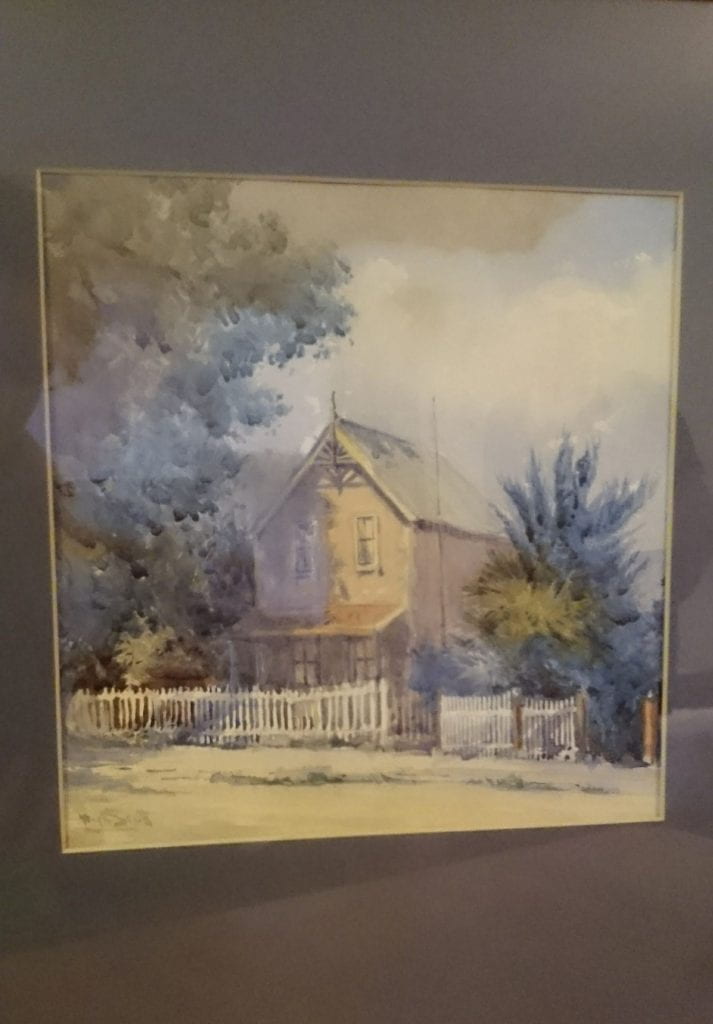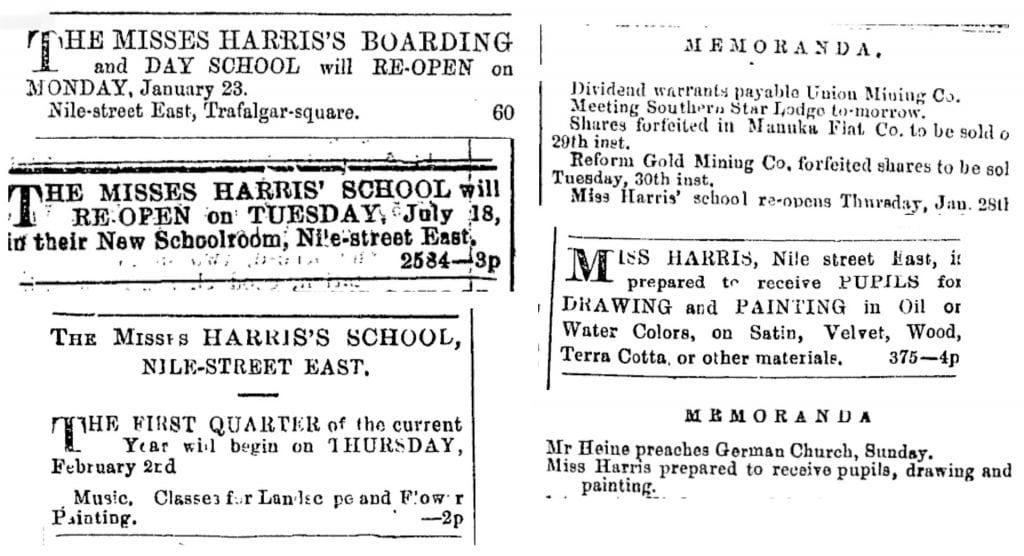By Michele Leggott
There was a longstanding tradition of teaching among the Harris women. It began with Sarah Harris teaching Sunday school soon after the family’s arrival in Taranaki in March 1841. Later Sarah established two elementary schools near the Harris farm in Frankley Rd in order to educate her own children and those of neighbours who could not afford to send their children to school in town. By the mid-1850s Emily and her sister Kate were teaching in their mother’s schools. In 1861 as the war came to a close in Taranaki, Emily was being advised by neighbours and friends in New Plymouth to set up her own school. She wrote to her parents in Nelson:
I then went to Mrs Dingle and made her an offer of taking her children to Nelson. But she could not make up her mind to part with them, she strongly recommended me to open a school here, she said that I should be certain to get plenty of scholars. I felt very much inclined to try and consulted Mrs Standish about it and she was of the same opinion. Mrs Dingle also offered me a home for a few weeks. They live in part of Richard Brown’s house, but where to get a school room is the great difficulty. (20 Feb 1861)
The school plan did not go ahead. Instead Emily took up her employer Charles Des Voeux’s offer of a passage to Sydney and Hobart, where she continued to work for the family as a nursery governess and housekeeper until 1865.
Emily was aware of the limited educational opportunities a settler upbringing had dealt her. She was also appreciative of the long-distance tutelage of her aunt Emma Jane Hill who taught at a boarding school for girls in Liskeard, Cornwall, from the 1840s until her death in 1866. Emma Hill corresponded regularly with her New Zealand nieces. ‘I received a letter from Aunt Emma by the last mail with a pretty neck ribbon enclosed in it,’ Emily tells her sister Frances. ‘She says she has received a very well expressed letter from you and wishes to include you in her list of pupils if you have no objection. She begs me to ask you, I am sure you will be very glad. Aunt Emma always criticizes my letters and points out the faults which I consider a great advantage.’ (29 Mar 1863)
Was it the example of Aunt Emma that persuaded the Harris sisters to set up a boarding school after Emily’s return from Hobart in 1865? One early advertisement for the venture reads:
MISSES HARRIS’S BOARDING and DAY SCHOOL will RE-OPEN on MONDAY, January 23. Nile-street East, Trafalgar-square. (Colonist 20 Jan 1871: 2)

From the ad we can infer that the school is located at or near the family home in Nile St, where Emily, Frances, Mary and Ellen were living with their parents. The death of their sister Augusta in 1870 and Mary’s forthcoming marriage to August Weyergang in October 1871 may have opened up boarding space in the house. Perhaps a schoolroom was rented nearby. From another ad we learn that the school moved at least once, though not far from the family home:
The Misses Harris’s School will reopen on Tuesday, July 18, in their New Schoolroom, Nile-street East. (Nelson Evening Mail 15 July 1882: 3)
What kind of school were the Harris sisters running in the 1870s and 1880s? No contemporary accounts survive but from Emily’s diaries 1885-1891 we can assume that it was a small establishment, catering to a handful of boys and girls between the ages of (say) six and twelve. There would have been basic instruction in reading, writing and arithmetic, with additional lessons offered in dancing (Frances and Ellen), music (Ellen), painting and drawing (Emily). After her successes at the Wellington Industrial Exhibition of 1885 and the Colonial and Indian Exhibition in London the following year, Emily was advertising tuition in decorative art to private pupils, who were usually older than her schoolchildren:
MISS HARRIS, Nile street East, is prepared to receive PUPILS for DRAWING and PAINTING in Oil or Water Colors, on Satin, Velvet, Wood, Terra Cotta, or other materials. (Nelson Evening Mail 1 Feb 1887: 3)
Emily and her sisters took their educational responsibilities seriously. The connection with the nearby Bishop’s School, where their father Edwin was drawing master from the mid 1860s until 1889, may have meant that their school had at least informal affiliation with the Church of England. It was certainly a preparatory school for higher education in Nelson. Reverend Samuel Poole, examiner for the BA degree, told Emily that the best-educated children he had examined had come from her school. She responded:
I’ do not get many pupils for all that,’ I said. Nevertheless I was glad to hear him say it especially as Mrs Lewis Gully told me a short time ago that Mabel who left our school for the ‘Girls High School’ last February had passed the Sixth Standard with great credit. The Inspector Mr W. Hudson said that she must have been exceedingly well taught. ‘And so,’ said Mrs Gully, ‘I thought I would tell you because it is a feather in your cap, as she never went to any other school before but yours.’ (22 Nov 1889)
How long did the Harris sisters teach Nelson children? The earliest advertisement we have found is for the school year 1871; the latest is for 1888. We know from Emily’s diaries that the school was in session 1885-1890. If it ran continuously, Emily and her sisters taught for almost 20 years in their adopted city. The death of Frances in 1892 may have signalled the end of the teaching enterprise, which was by Emily’s account already struggling in the late 1880s. The Education Act of 1877 began the standardisation of teaching and curricular and by the 1880s more and more Nelson children were likely to have been attending state schools in the area.
Two decades of teaching Nelson children must have left traces among families in the district. From Emily’s diaries we can pull out some names of boys and girls who attended the school in its later years: Claude Black, Ned Buckeridge, Arthur Cannaway, Mabel Gully, Gertie and Maudie Heaps, Chummy Levien, Birdie and Bertie Moore. More intriguing still is the possibility that among the many Nelson names in Emily’s diaries are those of ex-pupils, now grown up and part of the Harris sisters’ ongoing interest in the life and times of the city. Milly Boor, Lee Buckeridge, Hugh and Nelly Burnett, Lillie Burton, Ralph and Maud Catley, Alice Duncan, Florence Dunnage, Ralph Jackson, Totsie Levien, Emerson Mabin, Charlie and Clara Wright: any or all may be alumni of the Misses’ Harris school in Nile St.

Lead writer: Michele Leggott
Research support: Brianna Vincent, Makyla Curtis